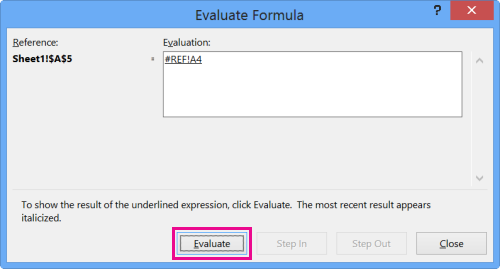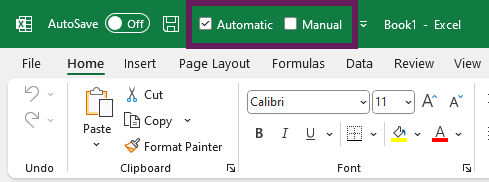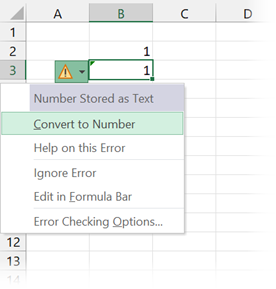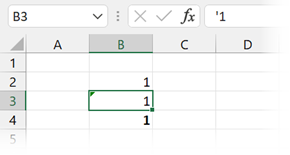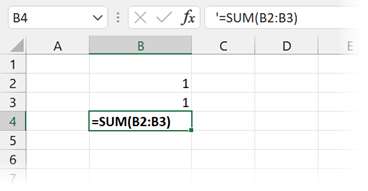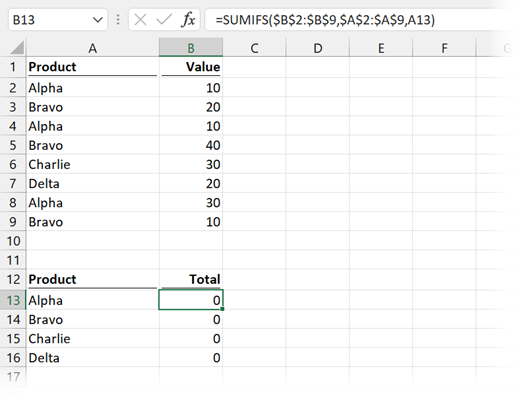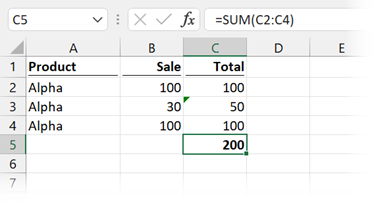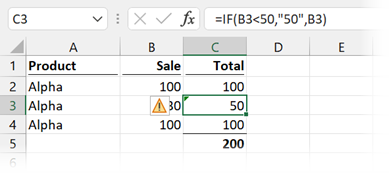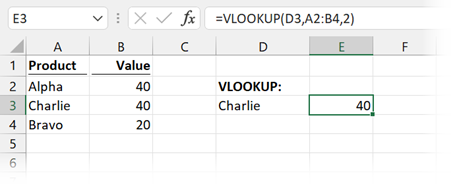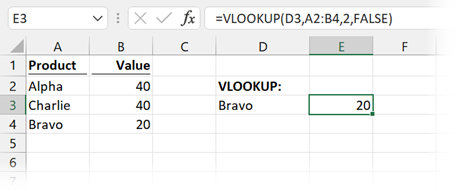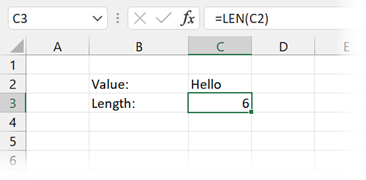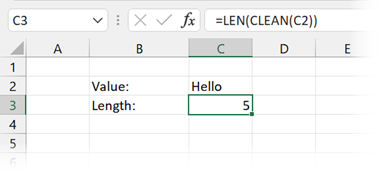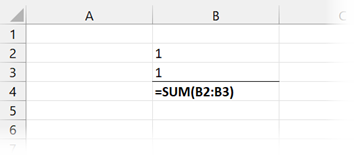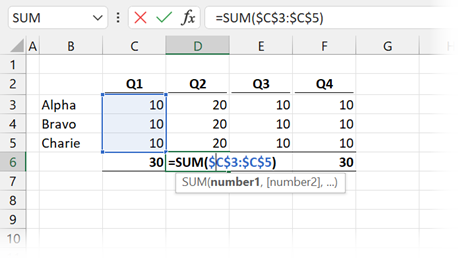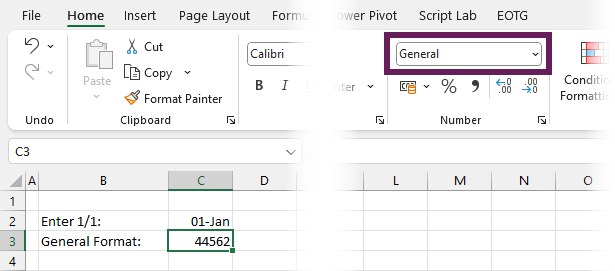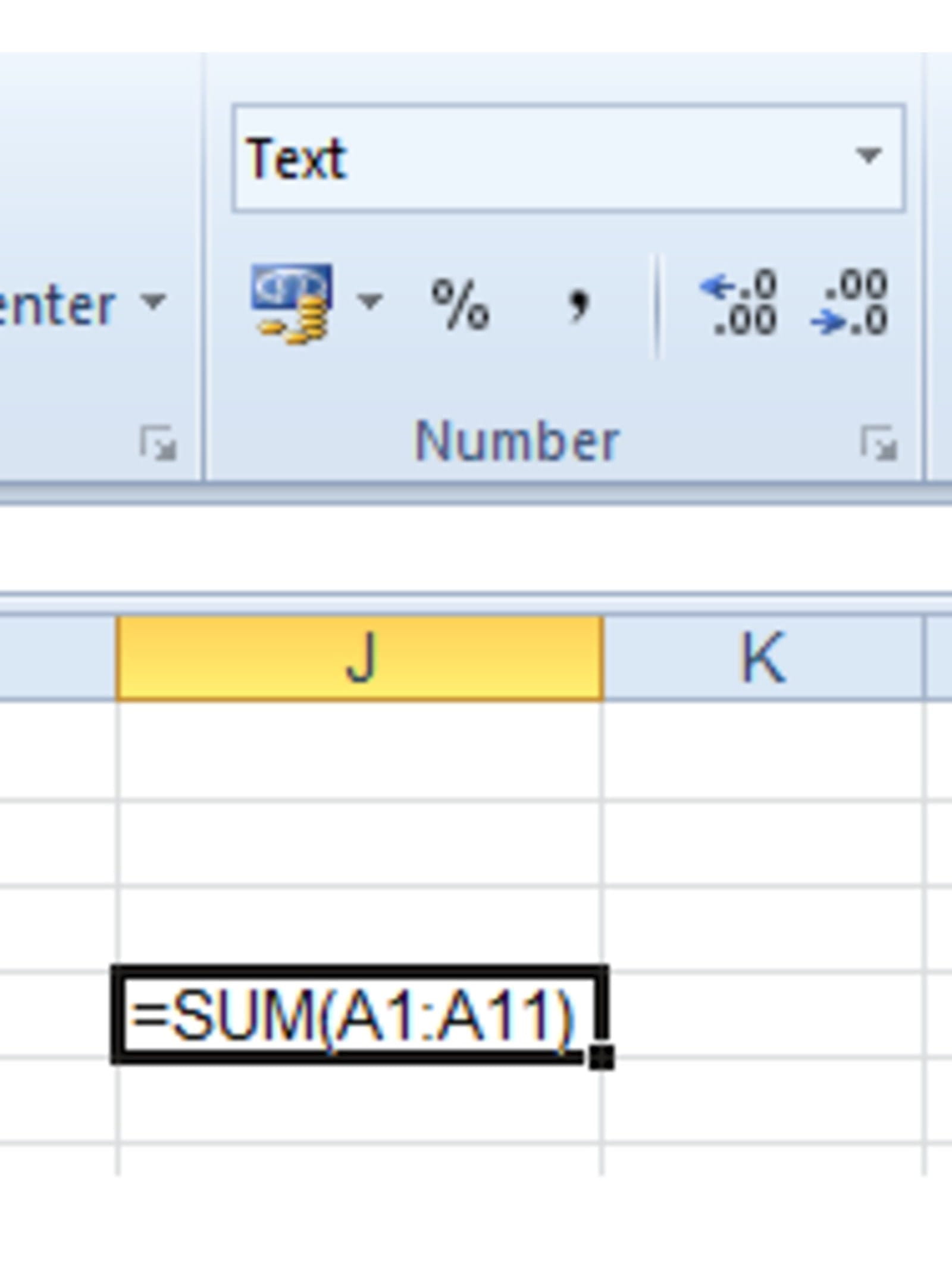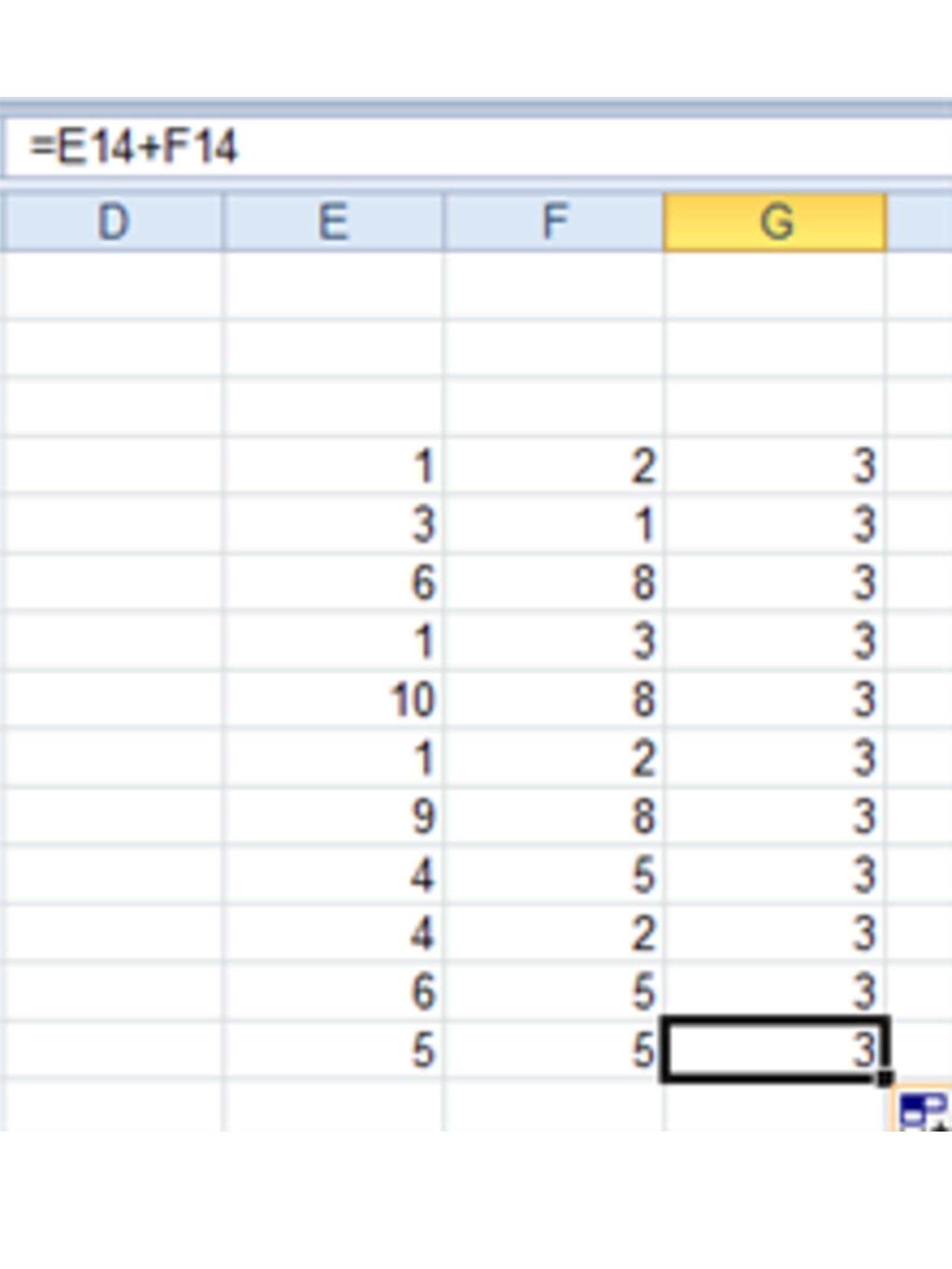Bottom Line: Learn about the different calculation modes in Excel and what to do if your formulas are not calculating when you edit dependent cells.
Skill Level: Beginner
Watch the Tutorial
Download the Excel File
You can follow along using the same workbook I use in the video. I’ve attached it below:
Why Aren’t My Formulas Calculating?
If you’ve ever been in a situation where the formulas in your spreadsheet are not automatically calculating as they should, you know how frustrating it can be.
This was happening to my friend Brett. He was telling me that he was working with a file and it wasn’t recalculating the formulas as he was entering data. He found that he had to edit each cell and hit Enter for the formula in the cell to update.
And it was only happening on his computer at home. His work computer was working just fine. This was driving him crazy and wasting a lot of time.
The most likely cause of this issue is the Calculation Option mode, and it’s a critical setting that every Excel user should know about.
To check what calculation mode Excel is in, go to the Formulas tab, and click on Calculation Options. This will bring up a menu with three choices. The current mode will have a checkmark next to it. In the image below, you can see that Excel is in Manual Calculation Mode.
When Excel is in Manual Calculation mode, the formulas in your worksheet will not calculate automatically. You can quickly and easily fix your problem by changing the mode to Automatic. There are cases when you might want to use Manual Calc mode, and I explain more about that below.
Calculation Settings are Confusing!
It’s really important to know how the calculation mode can change. Technically, it’s is an application-level setting. That means that the setting will apply to all workbooks you have open on your computer.
As I mention in the video above, this was the issue with my friend Brett. Excel was in Manual calculation mode on his home computer and his files weren’t calculating. When he opened the same files on his work computer, they were calculating just fine because Excel was in Automatic calculation mode on that computer.
However, there is one major nuance here. The workbook (Excel file) also stores the last saved calculation setting and can change/override the application-level setting.
This should only happen for the first file you open during an Excel session.
For example, if you change Excel to manual calc mode before you save & close the file, then that setting is stored with the workbook. If you then open that workbook as the first workbook in your Excel session, the calculation mode will be changed to manual.
All subsequent workbooks that you open during that session will also be in manual calculation mode. If you save and close those files, the manual calc mode will be stored with the files as well.
The confusing part about this behavior is that it only happens for the first file you open in a session. Once you close the Excel application completely and then re-open it, Excel will return to automatic calculation mode if you start by opening a new blank file or any file that is in automatic calculation mode.
Therefore, the calculation mode of the first file you open in an Excel session dictates the calculation mode for all files opened in that session. If you change the calculation mode in one file, it will be changed for all open files.
Note: I misspoke about this in the video when I said that the calculation setting doesn’t travel with the workbook, and I will update the video.
The 3 Calculation Options
There are three calculation options in Excel.
Automatic Calculation means that Excel will recalculate all dependent formulas when a cell value or formula is changed.
Manual Calculation means that Excel will only recalculate when you force it to. This can be with a button press or keyboard shortcut. You can also recalculate a single cell by editing the cell and pressing Enter.
Automatic Except for Data Tables means that Excel will recalculate automatically for all cells except those that are used in Data Tables. This is not referring to normal Excel Tables that you might work with frequently. This refers to a scenario-analysis tool that not many people use. You find it on the Data tab, under the What-If Scenarios button. So unless you’re working with those Data Tables, it’s unlikely you will ever purposely change the setting to that option.
In addition to finding the Calculation setting on the Data tab, you can also find it on the Excel Options menu. Go to File, then Options, then Formulas to see the same setting options in the Excel Options window.
Under the Manual Option, you’ll see a checkbox for recalculating the workbook before saving, which is the default setting. That’s a good thing because you want your data to calculate correctly before you save the file and share it with your co-workers.
Why Would I Use Manual Calculation Mode?
If you are wondering why anyone would ever want to change the calculation from Automatic to Manual, there’s one major reason. When working with large files that are slow to calculate, the constant recalculation whenever changes are made can sometimes slow your system. Therefore people will sometimes switch to Manual mode while working through changes on worksheets that have a lot of data, and then will switch back.
When you are in Manual Calculation mode, you can force a calculation at any time using the Calculate Now button on the Formulas tab.
The keyboard shortcut for Calculate Now is F9, and it will calculate the entire workbook. If you want to calculate just the current worksheet, you can choose the button below it: Calculate Sheet. The keyboard shortcut for that choice is Shift + F9.
Here is a list of all Recalculate keyboard shortcuts:
| Shortcut | Description |
| F9 | Recalculate formulas that have changed since the last calculation, and formulas dependent on them, in all open workbooks. If a workbook is set for automatic recalculation, you do not need to press F9 for recalculation. |
| Shift+F9 | Recalculate formulas that have changed since the last calculation, and formulas dependent on them, in the active worksheet. |
| Ctrl+Alt+F9 | Recalculate all formulas in all open workbooks, regardless of whether they have changed since the last recalculation. |
| Ctrl+Shift+Alt+F9 | Check dependent formulas, and then recalculate all formulas in all open workbooks, regardless of whether they have changed since the last recalculation. |
Macro Changing to Manual Calculation Mode
If you find that your workbook is not automatically calculating, but you didn’t purposely change the mode, another reason that it may have changed is because of a macro.
Now I want to preface this by saying that the issue is NOT caused by all macros. It’s a specific line of code that a developer might use to help the macro run faster.
The following line of VBA code tells Excel to change to Manual Calculation mode.
Application.Calculation = xlCalculationManual
Sometimes the author of the macro will add that line at the beginning so that Excel does not attempt to calculate while the macro runs. The setting should then changed be changed back at the end of the macro with the following line.
Application.Calculation = xlCalculationAutomatic
This technique can work well for large workbooks that are slow to calculate.
However, the problem arises when the macro doesn’t get to finish—perhaps due to an error, program crash, or unexpected system issue. The macro changes the setting to Manual and it doesn’t get changed back.
As I mention in the video, this was exactly what happened to my friend Brett, and he was NOT aware of it. He was left in manual calc mode and didn’t know why, or how to get Excel calculating again.
Therefore, if you are using this technique with your macros, I encourage you to think about ways to mitigate this issue. And also warn your users of the potential of Excel being left in manual calc mode.
I also recommend NOT changing the Calculation property with code unless you absolutely need to. This will help prevent frustration and errors for the users of your macros.
Conclusion
I hope this information is helpful for you, especially if you are currently dealing with this particular issue. If you have any questions or comments about calculation modes, please share them in the comments.
Maintenance Alert: Saturday, April 15th, 7:00pm-9:00pm CT. During this time, the shopping cart and information requests will be unavailable.
Excel Formulas Not Calculating? How to Fix it Fast
Categories: Basic Excel
You’ve created the reports for your management meeting, and, just before you print copies for the executives, you discover that the totals are all showing last month’s values. How do you fix it—fast?
1. Check for Automatic Recalculation
On the Formulas ribbon, look to the far right and click Calculation Options. On the dropdown list, verify that Automatic is selected.
When this option is set to automatic, Excel recalculates the spreadsheet’s formulas whenever you change a cell value. This means that, if you have a formula that totals up your sales and you change one of the sales, Excel updates the total to show the correct sum.
When this option is set to manual, Excel recalculates only when you click the Calculate Now or Calculate Sheet button. If you prefer keyboard shortcuts, you can recalculate by pressing the F9 key. Manual recalculation is useful when you have a large spreadsheet that takes several minutes to recalculate. Instead of waiting impatiently while it recalculates after every change you make, you can set the recalculation to manual, make all of your changes, and then recalculate at once.
Unfortunately, if you set it to manual and forget about it, your formulas will not recalculate.
2. Check the Cell Format for Text
Select the cell that is not recalculating and, on the Home ribbon, check the number format. If the format shows Text, change it to Number. When a cell is formatted as Text, Excel makes no attempt to interpret the contents as a formula.
After you change the format, you’ll need to reconfirm the formula by clicking in the Formula Bar and then pressing the Enter key.
Note: If you format a cell as General and you discover that Excel is changing it automatically to text, try setting it to Number. When a cell formatted as General and the cell contains a reference to another cell, Excel copies the format of the referenced cell. Choosing any format other than General will prevent Excel from changing the format.
3. Check for Circular References
Look at the bottom of the Excel window for the words CIRCULAR REFERENCES.
Like circular logic, a circular reference is a formula that either includes itself in its calculation or refers to another cell which depends on itself. Be aware that a circular reference can, in some instances, prevent Excel from calculating a formula. Correct the circular reference and recalculate your spreadsheet.
Next Steps
You can fix most recalculation problems with one of these three solutions. Now, fix that report, and get ready for your meeting.
Or continue your Excel education here.
PRYOR+ 7-DAYS OF FREE TRAINING
Courses in Customer Service, Excel, HR, Leadership,
OSHA and more. No credit card. No commitment. Individuals and teams.
How to avoid broken formulas
Excel for Microsoft 365 Excel for Microsoft 365 for Mac Excel for the web Excel 2021 Excel 2021 for Mac Excel 2019 Excel 2019 for Mac Excel 2016 Excel 2016 for Mac Excel 2013 Excel for iPad Excel for Android tablets Excel 2010 Excel 2007 Excel Starter 2010 More…Less
If Excel can’t resolve a formula you’re trying to create, you may get an error message like this one:
Unfortunately, this means that Excel can’t understand what you’re trying to do, so you’ll need to update your formula or make sure you’re using the function correctly.
Tip: There are a few common functions where you might run into issues, check out COUNTIF, SUMIF, VLOOKUP, or IF to learn more. You can also see a list of functions here.
Return to the cell with the broken formula, which will be in edit mode, and Excel will highlight the spot where it’s having a problem. If you still don’t know what to do from there and want to start over, you can press ESC again, or select the Cancel button in the formula bar, which will take you out of edit mode.
If you want to move forward, then the following checklist provides troubleshooting steps to help you figure out what may have gone wrong. Select the headings to learn more.
Note: If you’re using Microsoft 365 for the web, you may not see the same errors, or the solutions may not apply.
Excel throws a variety of pound (#) errors such as #VALUE!, #REF!, #NUM, #N/A, #DIV/0!, #NAME?, and #NULL!, to indicate something in your formula isn’t working properly. For example, the #VALUE! error is caused by incorrect formatting or unsupported data types in arguments. Or, you’ll see the #REF! error if a formula refers to cells that have been deleted or replaced with other data. Troubleshooting guidance will differ for each error.
Note: #### is not a formula-related error. It just means that the column isn’t wide enough to display the cell contents. Simply drag the column to widen it, or go to Home > Format > AutoFit Column Width.
Refer to any of the following topics corresponding to the pound error you see:
-
Correct a #NUM! error
-
Correct a #VALUE! error
-
Correct a #N/A error
-
Correct a #DIV/0! error
-
Correct a #REF! error
-
Correct a #NAME? error
-
Correct a #NULL! error
Each time you open a spreadsheet that contains formulas referring to values in other spreadsheets, you’ll be prompted to update the references or leave them as-is.
Excel displays the above dialog box to make sure that the formulas in the current spreadsheet always point to the most updated value in case the reference value has changed. You can choose to update the references, or skip if you don’t want to update. Even if you choose to not update the references, you can always manually update the links in the spreadsheet whenever you want.
You can always disable the dialog box from appearing at start up. To do that, go to File > Options > Advanced > General, and clear the Ask to update automatic links box.
Important: If this is the first time you’re working with broken links in formulas, if you need a refresher on resolving broken links, or if you don’t know whether to update the references, see Control when external references (links) are updated.
If the formula doesn’t display the value, follow these steps:
-
Make sure Excel is set to show formulas in your spreadsheet. To do this, select the Formulas tab, and in the Formula Auditing group, select Show Formulas.
Tip: You can also use the keyboard shortcut Ctrl + ` (the key above the Tab key). When you do this, your columns will automatically widen to display your formulas, but don’t worry, when you toggle back to the normal view, your columns will resize.
-
If the step above still doesn’t resolve the issue, it’s possible the cell is formatted as text. You can right-click on the cell and select Format Cells > General (or Ctrl + 1), then press F2 > Enter to change the format.
-
If you have a column with a large range of cells that are formatted as text, you can select the range, apply the number format of your choice, and go to Data > Text to Column > Finish. This will apply the format to all of the selected cells.
When a formula does not calculate, you’ll need to check if automatic calculation is enabled in Excel. Formulas won’t calculate if manual calculation is enabled. Follow these steps to check for Automatic calculation.
-
Select the File tab, select Options, and then select the Formulas category.
-
In the Calculation options section, under Workbook Calculation, make sure the Automatic option is selected.
For more information on calculations, see Change formula recalculation, iteration, or precision.
A circular reference occurs when a formula refers to the cell that it’s located in. The fix is to either move the formula to another cell, or change the formula syntax to one that avoids circular references. However, in some scenarios you may need circular references because they cause your functions to iterate—repeat until a specific numeric condition is met. In such cases, you’ll need to enable Remove or allow a circular reference.
For more information on circular references, see Remove or allow a circular reference.
If your entry doesn’t start with an equal sign, it isn’t a formula, and won’t be calculated—a common mistake.
When you type something like SUM(A1:A10), Excel shows the text string SUM(A1:A10) instead of a formula result. Alternatively, if you type 11/2, Excel shows a date, such as 2-Nov or 11/02/2009, instead of dividing 11 by 2.
To avoid these unexpected results, always start the function with an equal sign. For example, type: =SUM(A1:A10) and =11/2.
When you use a function in a formula, each opening parenthesis needs a closing parenthesis for the function to work correctly. Make sure that all parentheses are part of a matching pair. For example, the formula =IF(B5<0),»Not valid»,B5*1.05) won’t work because there are two closing parentheses, but only one opening parenthesis. The correct formula would look like this: =IF(B5<0,»Not valid»,B5*1.05).
Excel functions have arguments—values you need to provide for the function to work. Only a few functions (such as PI or TODAY) take no arguments. Check the formula syntax that appears as you start typing in the function, to make sure the function has the required arguments.
For example, the UPPER function accepts only one string of text or cell reference as its argument: =UPPER(«hello») or =UPPER(C2)
Note: You’ll see the function’s arguments listed in a floating function reference toolbar beneath the formula as you’re typing it.
Also, some functions, such as SUM, require numerical arguments only, while other functions, such as REPLACE, require a text value for at least one of their arguments. If you use the wrong data type, functions might return unexpected results or show a #VALUE! error.
If you need to quickly look up the syntax of a particular function, see the list of Excel functions (by category).
Don’t enter numbers formatted with dollar signs ($) or decimal separators (,) in formulas because dollar signs indicate Absolute References and commas are argument separators. Instead of entering $1,000, enter 1000 in the formula.
If you use formatted numbers in arguments, you’ll get unexpected calculation results, but you may also see the #NUM! error. For example, if you enter the formula =ABS(-2,134) to find the absolute value of -2134, Excel shows the #NUM! error, because the ABS function accepts only one argument, and it sees the -2, and 134 as separate arguments.
Note: You can format the formula result with decimal separators and currency symbols after you enter the formula using unformatted numbers (constants). It’s generally not a good idea to put constants in formulas, because they can be hard to find if you need to update later and they’re more prone to being typed incorrectly. It’s much better to put your constants in cells, where they’re out in the open and easily referenced.
Your formula might not return expected results if the cell’s data type can’t be used in calculations. For example, if you enter a simple formula =2+3 in a cell that’s formatted as text, Excel can’t calculate the data you entered. All you’ll see in the cell is =2+3. To fix this, change the cell’s data type from Text to General like this:
-
Select the cell.
-
Select Home and select the arrow to expand the Number or Number Format group (or press Ctrl + 1). Then select General.
-
Press F2 to put the cell in the edit mode, and then press Enter to accept the formula.
A date you enter in a cell that’s using the Number data type might be shown as a numeric date value instead of a date. To show a number as a date, pick a Date format in the Number Format gallery.
It’s fairly common to use x as the multiplication operator in a formula, but Excel can only accept the asterisk (*) for multiplication. If you use constants in your formula, Excel shows an error message and can fix the formula for you by replacing the x with the asterisk (*).
However, if you use cell references, Excel will return a #NAME? error.
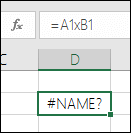
If you create a formula that includes text, enclose the text in quotation marks.
For example, the formula =»Today is » & TEXT(TODAY(),»dddd, mmmm dd») combines the text «Today is » with the results of the TEXT and TODAY functions, and returns say something like Today is Monday, May 30.
In the formula, «Today is » has a space before the ending quotation mark to provide the blank space you want between the words «Today is» and «Monday, May 30.» Without quotation marks around the text, the formula might show the #NAME? error.
You can combine (or nest) up to 64 levels of functions within a formula.
For example, the formula =IF(SQRT(PI())<2,»Less than two!»,»More than two!») has 3 levels of functions; the PI function is nested inside the SQRT function, which in turn is nested inside the IF function.
When you type a reference to values or cells in another worksheet, and the name of that sheet has a non-alphabetical character (such as a space), enclose the name in single quotation marks (‘).
For example, to return the value from cell D3 in a worksheet named Quarterly Data in your workbook, type: =’Quarterly Data’!D3. Without the quotation marks around the sheet name, the formula shows the #NAME? error.
You can also select the values or cells in another sheet to refer to them in your formula. Excel then automatically adds the quotation marks around the sheet names.
When you type a reference to values or cells in another workbook, include the workbook name enclosed in square brackets ([]) followed by the name of the worksheet that has the values or cells.
For example, to refer to cells A1 through A8 on the Sales sheet in the Q2 Operations workbook that’s open in Excel, type: =[Q2 Operations.xlsx]Sales!A1:A8. Without the square brackets, the formula shows the #REF! error.
If the workbook isn’t open in Excel, type the full path to the file.
For example, =ROWS(‘C:My Documents[Q2 Operations.xlsx]Sales’!A1:A8).
Note: If the full path has space characters, enclose the path in single quotation marks (at the beginning of the path and after the name of the worksheet, before the exclamation point).
Tip: The easiest way to get the path to the other workbook is to open the other workbook, then from your original workbook, type =, and use Alt+Tab to shift to the other workbook. Select any cell on the sheet you want, then close the source workbook. Your formula will automatically update to display the full file path and sheet name along with the required syntax. You can even copy and paste the path and use wherever you need it.
Dividing a cell by another cell that has zero (0) or no value results in a #DIV/0! error.
To avoid this error, you can address it directly and test for the existence of the denominator. You could use:
=IF(B1,A1/B1,0)
Which says IF(B1 exists, then divide A1 by B1, otherwise return a 0).
Always check to see if you have any formulas that refer to data in cells, ranges, defined names, worksheets, or workbooks before you delete anything. You can then replace these formulas with their results before you remove the referenced data.
If you can’t replace the formulas with their results, review this information about the errors and possible solutions:
-
If a formula refers to cells that have been deleted or replaced with other data, and if it returns a #REF! error, select the cell with the #REF! error. In the formula bar, select #REF! and delete it. Then enter the range for the formula again.
-
If a defined name is missing, and a formula that refers to that name returns a #NAME? error, define a new name that refers to the range you want, or change the formula to refer directly to the range of cells (for example, A2:D8).
-
If a worksheet is missing, and a formula that refers to it returns a #REF! error, there’s no way to fix this, unfortunately—a worksheet that’s been deleted can’t be recovered.
-
If a workbook is missing, a formula that refers to it remains intact until you update the formula.
For example, if your formula is =[Book1.xlsx]Sheet1′!A1 and you no longer have Book1.xlsx, the values referenced in that workbook stay available. However, if you edit and save a formula that refers to that workbook, Excel shows the Update Values dialog box and prompts you to enter a file name. Select Cancel, and then make sure this data isn’t lost by replacing the formulas that refer to the missing workbook with the formula results.
Sometimes, when you copy the contents of a cell, you want to paste just the value and not the underlying formula that’s displayed in the formula bar.
For example, you might want to copy the resulting value of a formula to a cell on another worksheet. Or you might want to delete the values that you used in a formula after you copied the resulting value to another cell on the worksheet. Both of these actions cause an invalid cell reference error (#REF!) to appear in the destination cell, because the cells that contain the values you used in the formula can no longer be referenced.
You can avoid this error by pasting the resulting values of formulas, without the formula, in destination cells.
-
On a worksheet, select the cells that contain the resulting values of a formula that you want to copy.
-
On the Home tab, in the Clipboard group, select Copy
.
Keyboard shortcut: Press CTRL+C.
-
Select the upper-left cell of the paste area.
Tip: To move or copy a selection to a different worksheet or workbook, select another worksheet tab or switch to another workbook, and then select the upper-left cell of the paste area.
-
On the Home tab, in the Clipboard group, select Paste
, and then select Paste Values, or press Alt > E > S > V > Enter for Windows, or Option > Command > V > V > Enter on a Mac.
To understand how a complex or nested formula calculates the final result, you can evaluate that formula.
-
Select the formula you want to evaluate.
-
Select Formulas > Evaluate Formula.
-
Select Evaluate to examine the value of the underlined reference. The result of the evaluation is shown in italics.
-
If the underlined part of the formula is a reference to another formula, select Step In to show the other formula in the Evaluation box. Select Step Out to go back to the previous cell and formula.
The Step In button isn’t available the second time the reference appears in the formula—or if the formula refers to a cell in another workbook.
-
Continue until each part of the formula has been evaluated.
The Evaluate Formula tool won’t necessarily tell you why your formula is broken, but it can help point out where. This can be a very handy tool in larger formulas where it might otherwise be difficult to find the problem.
Notes:
-
Some parts of the IF and CHOOSE functions won’t be evaluated, and the #N/A error might appear in the Evaluation box.
-
Blank references are shown as zero values (0) in the Evaluation box.
-
Some functions are recalculated every time the worksheet changes. Those functions, including the RAND, AREAS, INDEX, OFFSET, CELL, INDIRECT, ROWS, COLUMNS, NOW, TODAY, and RANDBETWEEN functions, can cause the Evaluate Formula dialog box to show results that are different from the actual results in the cell on the worksheet.
-

Need more help?
You can always ask an expert in the Excel Tech Community or get support in the Answers community.
Tip: If you’re a small business owner looking for more information on how to get Microsoft 365 set up, visit Small business help & learning.
See Also
Overview of formulas in Excel
Excel help & learning
Need more help?
We have all experienced it, and often at the worst possible moment. For whatever reason, Excel’s formulas aren’t calculating correctly. The good news is that it is usually something simple. Once we know the most likely causes, it is easier to troubleshoot the problem. So, in this post, we look at the most likely reasons for Excel formulas not calculating.
The 14 reasons and fixes in this post, should give you what you need to know. So, if you’re concerned that Excel has stopped calculating or that numbers aren’t updating, we have the answer for you.
Watch the video
Watch the video on YouTube
Calculation option – automatic or manual (#1)
Excel has two calculation options, Automatic and Manual. Most users don’t even know these two modes exist. Yet, frustratingly, in some circumstances, they can change without us knowing it.
Automatic calculation is the default mode. This is where formulas recalculate after any change affecting the result of a calculation.
Excel formulas are efficient at handling calculations. In the background, Excel knows which cells impact which formulas. Therefore, the Automatic calculation mode recalculates the minimum number of cells. This ensures Excel is fast while keeping all the values up-to-date. This is the behavior that we understand and expect.
However, due to the size and complexity of some spreadsheets or due to 3rd party add-ins, calculation speed can become very slow. This leads some users to change Excel’s option to Manual calculation mode. Consequently, Excel doesn’t recalculate anything. In Manual calculation mode, we can change cell values, but nothing happens. Therefore, we must explicitly tell Excel when to recalculate.
Therefore, if Excel is in manual calculation mode, it would appear there is an issue because we see Excel formulas not calculating.
NOTE: Unfortunately, Excel can change between Manual and Automatic calculation modes without us knowing it. So check out this post: Why does Excel’s calculation mode keep changing?
To determine which calculation mode is enabled, click Formulas > Calculation Options (drop-down). The tick inside the drop-down identifies which calculation option is applied.
Click Automatic to ensure the calculation happens automatically.
Calculation mode is an application-level setting; therefore, it applies to all open workbooks.
If you want to remain in Manual calculation mode, here are some useful shortcuts.
- F9: Calculates formulas that have changed since the last calculation, and formulas dependent on them, in all open workbooks.
- Shift + F9: Calculates formulas that have changed since the last calculation, and formulas dependent on them, in the active worksheet.
- Ctrl + Alt + F9: Calculates all formulas in all open workbooks, regardless of whether they have changed since the last time or not.
- Ctrl + Shift + Alt + F9: Rechecks dependent formulas and then calculates all formulas in all open workbooks, regardless of whether they have changed since the last time or not.
This is probably the #1 reason why we see Excel formulas not calculating.
TOP TIP: Add the Automatic/Manual calculation options to your QAT. This is an easy way to switch between modes and identify which mode is active.
Wrong number format (#2)
When looking at cell values, we decide what kind of data it is. We know instinctively that numbers can be aggregated, but text cannot. Unfortunately, Excel isn’t so clever.
Within Home > Number, we can select the cell format.
If a cell is formatted as text instead of a number, Excel may not calculate and may not display the value we expect.
Look at the screenshot below.
In Cell B4, the SUM of B2:B3 equals 1; 1+1 = 1 is definitely wrong. This is because B3 is formatted as text, and the SUM function ignores text. So, while the calculation may look like 1+1 = 1 (which is wrong), it is actually 1+0 = 1 (which is correct).
To fix this, here are 3 options:
- Manual change
- Change the cell format from Text to another format (General is a good option to start with)
- Double-click on the problem cell to go into edit mode
- Press return to commit the formula
- If the cell has a green triangle:
- Click on the cell
- Select Convert to number from the warning drop-down
- Adding zero to the number
- Select any blank cell.
- Copy the cell
- Select the cells to be converted to numbers
- Click Home > Paste > Paste Special…
- In the Paste Special window, select Add, then click OK
#1 specifically relates to numbers formatted as text, but #2 and #3 can be used in many scenarios where numbers are stored as text.
Leading apostrophe (#3)
The apostrophe ( ‘ ) is a special character in Excel. Whenever an apostrophe is entered at the start of a value or formula, this tells Excel that everything that follows is text.
This special character ensures we can store numbers as text. For example, if we wanted to hold an employee number containing leading zeros, Excel might remove the zeros on data entry.
Therefore, we insert the apostrophe to ensure Excel understands this as text.
However, sometimes an apostrophe can appear when we don’t want it. This often happens when the data is imported from an external system.
The screenshot below shows a calculation that doesn’t work as expected. The formula in Cell B4 is SUM(B2:B3), therefore 1 + 1 = 2, yet the value in B4 equals 1. This is because cell B3 contains a value with an apostrophe preceding it.
Either remove the apostrophe manually or use techniques #2 and #3 listed in the section above to fix the issue.
There is a similar impact on formulas. For example, in the screenshot below, the SUM function has a leading apostrophe; therefore, it is treated as text.
As it’s a formula, you will need to remove the apostrophe manually. Then you’re good to go.
Leading and trailing spaces (#4)
Leading and trailing spaces are a big problem, they often occur in imported text, but we cannot see them with our eyes.
Let’s look at an example.
In the screenshot above, the formula in Cell B13 is:
=SUMIFS($B$2:$B$9,$A$2:$A$9,A13)We are performing a basic SUMIFS function to add the values for product Alpha. Based on the data, the value should be 50, but it calculates as zero.
The problem is that all the values in Cells A2:A9 have trailing spaces. Rather than “Alpha”, used in Cell A13 for the SUMIFS function, the value in the data is “Alpha “ (with trailing spaces). Excel views these as different values. As a result, there is no match.
To fix this, there are lots of options. Some suggestions are:
- Manually removing the space from the data
- Adding the trailing space into our SUMIFS criteria
- Using the TRIM function to remove extra spaces from the start/end of the text
- If there are no spaces in the middle of the text, we can use Find and Replace to remove extra spaces.
Numbers contained in double quotes (#5)
Another text/number mix-up issue occurs when numbers are included in double-quotes.
Look at the screenshot below. There is a problem; 100+50+100 definitely does not equal 200.
In this scenario, there is a minimum sale volume of 50; therefore, using an IF function, the value in row 3 has increased correctly from 30 to 50. Consequently, the total should be 250. So, what’s happened?
The problem is due to the calculation in Cell C3.
The formula is:
=IF(B3<50,"50",B3)In Cell B3, the value is less than 50; therefore, the text value of “50” is returned in Cell C3. The double quotes tell Excel that this is text and not a number.
To fix this, remove the double quotes around the number 50. Then the correct total will be calculated.
Incorrect formula arguments (#6)
Excel functions are a programming language for calculating a result. Each function has its own syntax (i.e., the arguments required to calculate an outcome). If we get this syntax wrong, it can lead to unexpected results.
VLOOKUP is a very error-prone function; it has caught out many unsuspecting users.
Let’s take a look at an example.
In the example above, the formula in Cell E3 is:
=VLOOKUP(D3,A2:B4,2)It results 40 for Charlie, which is correct.
Now let’s change the value in D3 to Bravo:
It still returns 40!! Bravo should be 20. How is that possible?
In our formula, we excluded VLOOKUP’s 4th argument, which is the Range_Lookup argument.
- If we enter TRUE or exclude this argument, we are telling Excel that :
- the first column in our data is in sorted ascending order
- we want to return the value closest to, but not greater, than the lookup value (known as an approximate match).
- If we enter FALSE as the fourth argument, Excel only returns an exact match.
Our first column is not in ascending order, but by excluding the 4th argument, Excel believes it is sorted. Therefore, Excel calculated the wrong result.
If we go back and change our formula, so the 4th argument is FALSE, it works.
This demonstrates the importance of understanding what all function arguments do.
Non-printed characters (#7)
Non-printed characters are letters used within computer code that a person cannot view. As a simple example, the line break character we can enter into Excel using Alt + Enter is not printable.
In the screenshot above, the LEN function shows 6 characters in Cell C2. But the word “Hello” only has 5 characters.
There are no spaces in Cell C2, so what’s going on? It’s because there is a trailing line break character.
We can remove non-printed characters using the CLEAN function.
Look at the screenshot above. Once we’ve used the CLEAN function, the value is now correct again.
Circular references (#8)
Circular references are where a formula refers to a cell within its own calculation chain. Here is an example.
The formula in Cell B5 is:
=SUM(B2:B5)If you notice, the cell reference of the formula (B5) is included within the range of cells (B2:B5). Consequently, Excel cannot calculate a result (unless iterative calculations have been enabled).
When we create or open a workbook with circular references, Excel will often display an error message:
“There are one or more circular references where a formula refers to its own cell either directly or indirectly. This might cause them to calculate incorrectly.
Try removing or changing these references, or moving the formulas to different cells.“
But, error messages don’t stop us from clicking OK and continuing as if nothing is wrong.
If there are circular references, they can be tough to find manually. Thankfully, Excel has given us a tool within the Formulas > Formula Auditing > Error Checking > Circular References which displays the circular references in any of our open workbooks.
As shown in the screenshot above, Cell B5 has a circular reference. Once we remove that, it will calculate correctly.
Show formulas (#9)
In Excel, we usually view the results of calculations. However, with one mouse click or one shortcut, we can quickly toggle to show formulas rather than results.
Turning on show formulas can easily be performed by accident or saved in this state by a previous user.
To display the formula results again, click Formulas > Formula Auditing> Show Formulas, or use the shortcut key Ctrl + ` (the key to the left of the 1 key on a standard windows keyboard).
Incorrect cell references (#10)
One thing we learn in Excel quite early on is the use of the dollar ($) symbol to lock cell references. For example:
- If we enter =A1 into a cell and copy it down, it will change to =A2.
- If we enter =A$1 and copy the cell down, it will remain as =A$1.
We get used to this referencing syntax quickly. However, this makes it easy to make mistakes when copying formulas to other cells.
Look at the screenshot above. There is definitely an issue with the calculation in Cell D6.
Double-click on the cell, and the problem will quickly reveal itself.
Yes… somebody forgot that $ symbols had been used in the formula in Cell C6, then they copied the formula into Cells D6 to F6.
Unfortunately, it’s easily done; I’ve done it myself many times.
How can we find these types of errors? The only way is to check our work as we go, and apply a healthy bit of skepticism to any calculation result. It’s better to self-review and find an error than to sit in a meeting with your manager, and them find it.
Automatic data entry conversion (#11)
To help reduce the number of errors we make, Excel is programmed to auto-correct / auto-change some data as we enter it. This is great most of the time, and who knows how often it has saved us from an embarrassing mistake.
Dates
However, auto-correction can cause problems at other times. For example, what do we want if we enter 1/1 into Excel? Do we want the result of 1? Or do we want 1st January? In this case, Excel assumes we want 1st January of the current year.
Dates are the most common type of automatic conversion. Dates in Excel are actually numbers, based on the number of days since 31st December 1899. So, assuming the current year is 2022, if we enter 1/1, Excel thinks we want 1st January 2022 (which is the number 44562). We can see this when we change the date to a number format.
We tried to enter a value of 1/1 and ended up with a value of 44562. Hmmm… that could cause us an issue.
Leading Zeros (#12)
We have already seen above in #3 that leading zeros can be a problem.
If we try to enter a number with leading zeros, such as 0005321, Excel assumes we don’t want the leading zeros and converts the number to 5321.
To retain leading zeros, we should either:
- Add an apostrophe at the start
- Convert the data type to text before entering value
Hidden rows and columns (#13)
This is one of my pet peeves. Hidden rows and columns cause so many problems for Excel users. In my opinion, they should be avoided at all costs.
Let’s look at an example:
Look at the screenshot above. The formula in Cell B5 is:
=SUM(B2:B4)Is this result correct? Actually, Yes. But the hidden row make the result look wrong. This is because the hidden row contains an additional value, as we can see when we unhide row 3.
If we want a calculation that excludes hidden cells, we should consider using the AGGREGATE or SUBTOTAL function.
Binary to decimal conversion (#14)
Computers store numbers using binary (a mixture of 1 and 0’s). Yet we learn numbers using a decimal base 10 system. As a result, Excel must convert between binary and decimal numbers, which can lead to some unexpected differences.
We know one-third (1/3) cannot be expressed as a decimal; it calculates as 0.333333… recurring into infinity. So we tend to use an approximation with a reduced number of digits.
In binary, there are also numbers that have a recurring number into infinity. One-tenth (1/10) can easily be expressed as a decimal: 0.1. But in binary, it is 00011001100110011… recurring into infinity.
Excel calculates to 15 significant digits. Therefore, it is possible for minor rounding differences to occur due to the conversion from binary to decimal. While this may be insignificant, if this is used in a logic statement, it can lead to an alternative result.
Check out this post for more details: Excel can calculate the wrong results: WARNING
Conclusion
In this post we have given you the most likely reasons we find Excel formulas not calculating as expected. I trust these 14 techniques have helped to solve your problem.
If you’ve found any other simple issues which cause incorrect calculations, please add them in the comments below.
Related posts:
- Why does Excel’s calculation mode keep changing?
- 7 ways to remove additional spaces in Excel
About the author
Hey, I’m Mark, and I run Excel Off The Grid.
My parents tell me that at the age of 7 I declared I was going to become a qualified accountant. I was either psychic or had no imagination, as that is exactly what happened. However, it wasn’t until I was 35 that my journey really began.
In 2015, I started a new job, for which I was regularly working after 10pm. As a result, I rarely saw my children during the week. So, I started searching for the secrets to automating Excel. I discovered that by building a small number of simple tools, I could combine them together in different ways to automate nearly all my regular tasks. This meant I could work less hours (and I got pay raises!). Today, I teach these techniques to other professionals in our training program so they too can spend less time at work (and more time with their children and doing the things they love).
Do you need help adapting this post to your needs?
I’m guessing the examples in this post don’t exactly match your situation. We all use Excel differently, so it’s impossible to write a post that will meet everybody’s needs. By taking the time to understand the techniques and principles in this post (and elsewhere on this site), you should be able to adapt it to your needs.
But, if you’re still struggling you should:
- Read other blogs, or watch YouTube videos on the same topic. You will benefit much more by discovering your own solutions.
- Ask the ‘Excel Ninja’ in your office. It’s amazing what things other people know.
- Ask a question in a forum like Mr Excel, or the Microsoft Answers Community. Remember, the people on these forums are generally giving their time for free. So take care to craft your question, make sure it’s clear and concise. List all the things you’ve tried, and provide screenshots, code segments and example workbooks.
- Use Excel Rescue, who are my consultancy partner. They help by providing solutions to smaller Excel problems.
What next?
Don’t go yet, there is plenty more to learn on Excel Off The Grid. Check out the latest posts:
Home/ Formulas/ 5 Reasons Why your Excel Formula is Not Calculating
When your Excel formula is not calculating, or not updating, it can be very frustrating. Your formulas are the driving force for your spreadsheet.
There are 5 reasons for your Excel formula not calculating. In this tutorial we explain these 5 scenarios.
Watch the Video – Excel Formula Not Calculating
1. Calculation Options is Set to Manual
The first thing that you should check is that the calculation options are not set to manual. This is the most likely problem.
Click the Formulas tab and then the Calculation Options button.
If this is set to manual, the formulas will not update unless you press the Calculate Now or Calculate Sheet buttons.
Change it to Automatic and the formulas will start working.
This setting can be changed by macros, or by other workbooks that you may have opened first. So if you are not aware of this setting, it could still be a reason for the formula not calculating.
2. Formula Not Calculating as Cell is Formatted as Text
Another common reasons is accidentally formatting the cells containing formulas as text. These will not calculate whilst in this format.
To check this; click on the cell and check the Number group of the Home tab.
If it displays Text. Change the format to General using the list provided.
Then re-calculate the formula in the cell by double clicking on the cell and pressing Enter.
3. A Space is Entered Before the Equals
When typing the formula be sure not to enter a space before the equals. This is difficult to notice so can go unrecognised, however it will prevent the formula from calculating.
Double click the cell, or edit it in the Formula Bar. Check if there is a space and if so delete it. The formula will update.
4. An Apostrophe is Entered Storing the Formula as Text
When an apostrophe (‘) is entered before typing in Excel, that tells Excel to store the content as text. This is a common approach to store numbers such as phone numbers as text to retain the leading zeros.
This however could be the reason why your formula is not calculating.
The apostrophe will not be visible in the cell on the spreadsheet, but you can see it in the Formula Bar.
Double click the cell, or edit it in the Formula Bar and delete the apostrophe.
5. The Show Formulas button is Turned On
The final reason could be that the Show Formulas button on the Formulas tab is turned on. This can easily be done accidentally, or possibly by someone else using this workbook previously.
This button is used when auditing formulas. It shows the formula instead of the formula result, stopping them from calculating. This can be helpful when troubleshooting formula problems.
Simply click the Show Formulas button again to turn it off and the formula will be working.
More Awesome Excel Tutorials
- Using Wildcard characters in Excel formulas
- Prevent formulas from showing in the Formula Bar
- Troubleshooting formulas in Excel
- Formula to extract a postcode from a UK address
- Is Udemy the right E-learning platform for you?
Reader Interactions
Hello all and welcome back to the Excel Tip of the Week — it’s our birthday! Today the TOTW is one year old. I hope you’ve enjoyed the posts to date and I am looking forward to another great year of tips, tricks, and ideas.
Because we’ve now covered so much, from now every so often we will take a week to revisit a popular older topic. This will let the TOTW continue to teach core Excel topics without becoming stale.
Anyhow, for this week, we have a Creator post in which we will be taking a look at a few causes of a common Excel problem: formulas not calculating properly.
This blog is also available on YouTube.
Possible cause 1: Cells are formatted as text
Description: A cell contains what looks like a formula, but the formula doesn’t calculate. Instead the text of the formula itself appears in the cell directly. See example below.
Cause: The cell is formatted as Text, which causes Excel to ignore any formulas. This could be directly due to the Text format, or is particularly common when importing data from a CSV or Notepad file.
Fix: Change the format of the cell(s) to General or some other format. However, the formulas still won’t start working until you force Excel to reconsider the content. You can do this in one of two ways.
Method 1: Jump into the affected cell (mouse click or F2) and then immediately exit again. This is quicker for a single formula but if there are many formulas it will be time-consuming and you should use Method 2 instead.
Method 2: Use Find and Replace (Ctrl + F). Choose to replace = with = and this will cause Excel to refresh the formulas and begin calculating as normal.
Possible cause 2: The workbook is set to Manual calculation
Description: A selection of formulas are written correctly, but display results that don’t agree to the correct inputs or don’t make sense.
Cause: The workbook has been placed in “Manual calculation” mode. This will mean that Excel doesn’t automatically update all formulas whenever the workbook is amended and needs to be manually forced to do so. This also means that if you copy and paste a formula (like the addition formula shown on the right), the result is copied instead of the correct answer until the manual recalculation prompt is used.
Fix: You can either force a manual recalculation, or turn the calculation back to automatic. Note that manual calculation is usually set when the workbook is very large and unwieldy to speed up calculation times.
Method 1: You can force a manual recalculation either by pressing the Calculate button in the bottom left most corner of Excel, or by pressing F9.
Method 2: You can switch the workbook back to Automatic calculation from Formulas => Calculation options.
These two are the cause of 99% of problems of this type.
Last reviewed: December 2021.
Excel community
This article is brought to you by the Excel Community where you can find additional extended articles and webinar recordings on a variety of Excel related topics. In addition to live training events, Excel Community members have access to a full suite of online training modules from Excel with Business.
-
Join the Excel Community

Staying ahead in a digital era
ICAEW’s Finance in a Digital World is a suite of online learning modules to support members to develop awareness and build understanding of digital technologies and their impact on finance.
-
Find out more

- Archive
In this article, we will learn Why Is Your Excel Formula Not Calculating?.
Scenario:
Many times, like when we extract numbers out of string, they are text by property. You can’t do any number operations on them. Then we get the need of converting that text to a number. So to convert any text to a number we can take various approaches depending on the situation. Let’s have a look at those approaches…
Use VALUE Function to Convert Text into Number
So if you downloaded sum data from a website, it’s common to get some numbers as text format special dates. Just wrap these text into a VALUE function. It will return a pure number.
VALUE function Syntax
So to convert a text in cell B2 into number write this VALUE formula.
Add 0 to text to Convert Text into Number
If you add any number using + operator to a text formatted number, it will convert the text to a number and then add the given number to the converted number. Finally the result will be a number.
For example if there is a text formatted number in B4, then just add 0 to convert string to number.
Result will be a number for sure.
As I told you in the beginning, this problem occurs when we extract numbers from strings. So if you want the extracted text to be numbered just add 0 in the end.
For example I am extracting citycode from text B6. I extracted it using the LEFT function. But it’s not a number so I added a 0 in the formula itself.
Using Excel Notification to Convert Text into Number
Whenever a number is in the form of a text, excel notifies you by showing a green corner of the cell.
When you click on the cell it shows a small exclamation icon at the left corner of the cell.
When you click on it, it shows an option of Convert to Number. Click on it and the text will be converted to number.
Convert Text to Number using VBA
So, if you have a fixed range that you want to convert to text then use this VBA snippet.
Sub ConvertTextToNumber()
Range("A3:A8").NumberFormat = "General"
Range("A3:A8").Value = Range("A3:A8").Value
End Sub
When you run the above code it converts the text of range A3:A8 into text.
This code can look more elegant if we write it like this.
Sub ConvertTextToNumber()
With Range("A3:A8")
.NumberFormat = "General"
.Value = .Value
End With
End Sub
How does it work?
Well, it is quite simple. We first change the number format of the range to General. Then we put the value of that range into the same range using VBA. This removes the text formatting completely. Simple, isn’t it?
Change the number of formatting of a dynamic range
In the above code, we changed the text to number in the above code of a fixed range but this will not be the case most of the time. To convert text to a number of dynamic ranges, we can evaluate the last used cell or select the range dynamically.
This is how it would look:
Sub ConvertTextToNumber()
With Range("A3:A" & Cells(Rows.Count, 1).End(xlUp).Row)
.NumberFormat = "General"
.Value = .Value
End With
Here, I know that the range starts from A3. But I don’t know where it may end.
So I dynamically identify the last used excel row that has data in it using the VBA snippet Cells(Rows.Count, 1).End(xlUp).Row. It returns the last used row number that we are concatenating with «A3:A».
Note: This VBA snippet will work on the active workbook and active worksheet. If your code switches through multiple sheets, it would be better to set a range object of the intended worksheet. Like this
Sub ConvertTextToNumber()
Set Rng = ThisWorkbook.Sheets("Sheet1").Range("A3:A" & Cells(Rows.Count, 1).End(xlUp).Row)
With Rng
.NumberFormat = "General"
.Value = .Value
End With
End Sub
The above code will always change the text to the number of the sheet1 of the workbook that contains this code.
Loop and CSng to change the text to number
Another method is to loop through each cell and change the cell value to a number using the CSng function. Here’s the code.
Sub ConvertTextToNumberLoop()
Set Rng = ThisWorkbook.Sheets("Sheet1").Range("A3:A" & Cells(Rows.Count, 1).End(xlUp).Row)
For Each cel In Rng.Cells
cel.Value = CSng(cel.Value)
Next cel
End Sub
In the above VBA snippet, we are using VBA For loop to iterate over each cell in the range and convert the value of each cell into a number using the CSng function of VBA.
So yeah guys, this is how you can change texts to numbers in Excel using VBA. You can use these snippets to ready your worksheet before you do any number operation on them. I hope I was explanatory enough. You can download the working file here.
Change Text to Number Using VBA.
Hope this article about Why Is Your Excel Formula Not Calculating is explanatory. Find more articles on calculating values and related Excel formulas here. If you liked our blogs, share it with your friends on Facebook. And also you can follow us on Twitter and Facebook. We would love to hear from you, do let us know how we can improve, complement or innovate our work and make it better for you. Write to us at info@exceltip.com.
Related Articles :
How to get Text & Number in Reverse through VBA in Microsoft Excel : To reverse number and text we use loops and mid function in VBA. 1234 will be converted to 4321, «you» will be converted to «uoy». Here’s the snippet.
Format data with custom number formats using VBA in Microsoft Excel : To change the number format of specific columns in excel use this VBA snippet. It converts the number format of specified to specified format in one click.
Popular Articles :
How to use the IF Function in Excel : The IF statement in Excel checks the condition and returns a specific value if the condition is TRUE or returns another specific value if FALSE.
How to use the VLOOKUP Function in Excel : This is one of the most used and popular functions of excel that is used to lookup value from different ranges and sheets.
How to use the SUMIF Function in Excel : This is another dashboard essential function. This helps you sum up values on specific conditions.
How to use the COUNTIF Function in Excel : Count values with conditions using this amazing function. You don’t need to filter your data to count specific values. Countif function is essential to prepare your dashboard.
Your Excel results are obviously wrong? Maybe you’ve just changed something but the results are still the same, Excel is not updating the results? Here are four potential reasons and fixes if your Excel file is not calculating any longer.

This article is part of our big Excel FAQ.
Learn about all the most frequently asked questions. Or ask a questions yourself!
Reason 1: Manual calculation mode

The first and frequent reason is that your workbook is set to manual calculation. That way, Excel recalculates your workbook only when you ask it to do. The solution is very easy:
Press F9 on the keyboard. That way, all changed formulas and their depending cells will be recalculated.
If you want to switch back the calculation mode to “Automatic”, go to the Formulas ribbon, click on Calculation Options on the right and then on “Automatic“.
For more information about the calculation modes in Excel, please refer to our detailed article.
Reason 2: Broken calculation chain so that some cells are not calculating
In some rare cases, pressing F9 doesn’t solve the problem. Try to press Ctrl + Alt + F9 on the keyboard. That way, all formulas – no matter if they changed or not – will be recalculated. Also, calculation chains in the background will be refreshed.
Please note: Pressing Ctrl + Alt + F9 usually solves the problem for very large workbooks, also in combination with the manual calculation mode. For small, simple Excel files typically this is not the solution.
Reason 3: Circular references might prevent calculating
Have you heard of circular references in Excel? Just a very simple example: Cell B2 refers to C2 and C2 to B2. Usually, Excel would provide a warning message and show it in the Status bar below the worksheet.

If your Excel file (or any other file open in the background) contains Circular References, your file might not calculate as usual.
The solution is to solve the Circular References. Here is everything you should know about circular references and how to remove them.
Do you want to boost your productivity in Excel?
Get the Professor Excel ribbon!
Add more than 120 great features to Excel!
Reason 4: Result is correct but not as expected
The methods above have not solved the problem? I hate to say it – but often Excel is working correctly. Usually there is a problem with your formulas and functions. So, are you really sure that the result has some Excel calculation errors…?
Reason 5: Results with very strange digits
If you experience basically correct results but with very long and strange looking digits (for example something like “-2,77556E-17”)
Please refer to this article, it explains the problem and solution in detail!
Image by Wolfgang Eckert from Pixabay
Henrik Schiffner is a freelance business consultant and software developer. He lives and works in Hamburg, Germany. Besides being an Excel enthusiast he loves photography and sports.

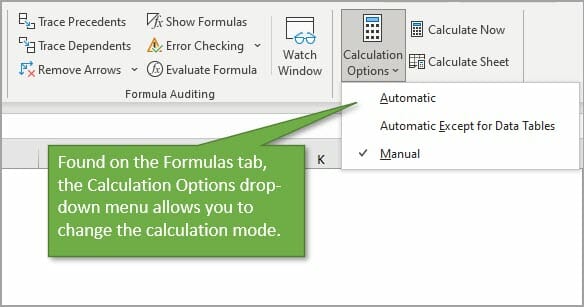
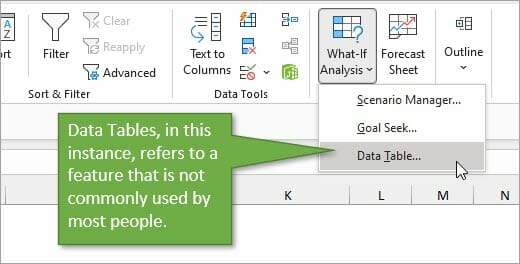
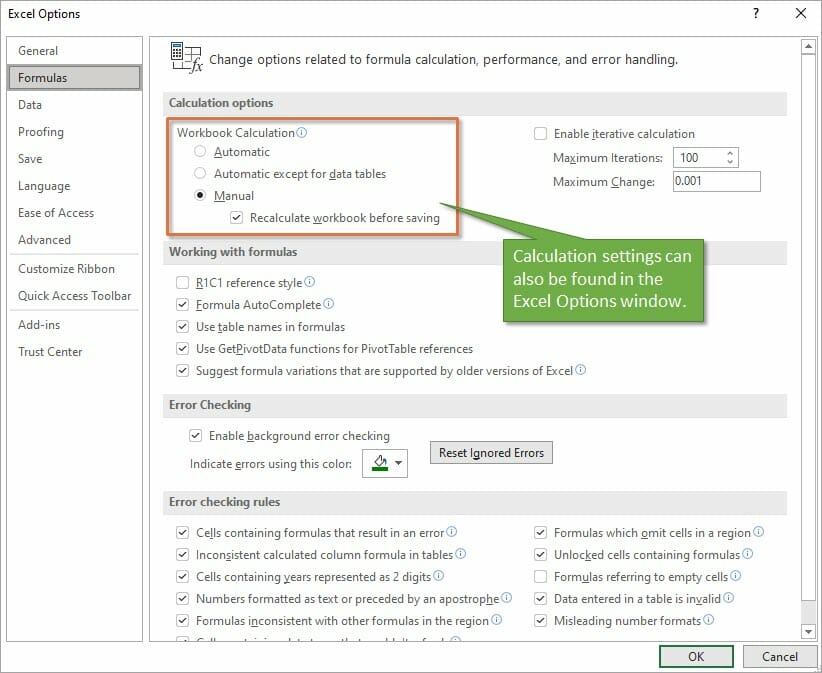

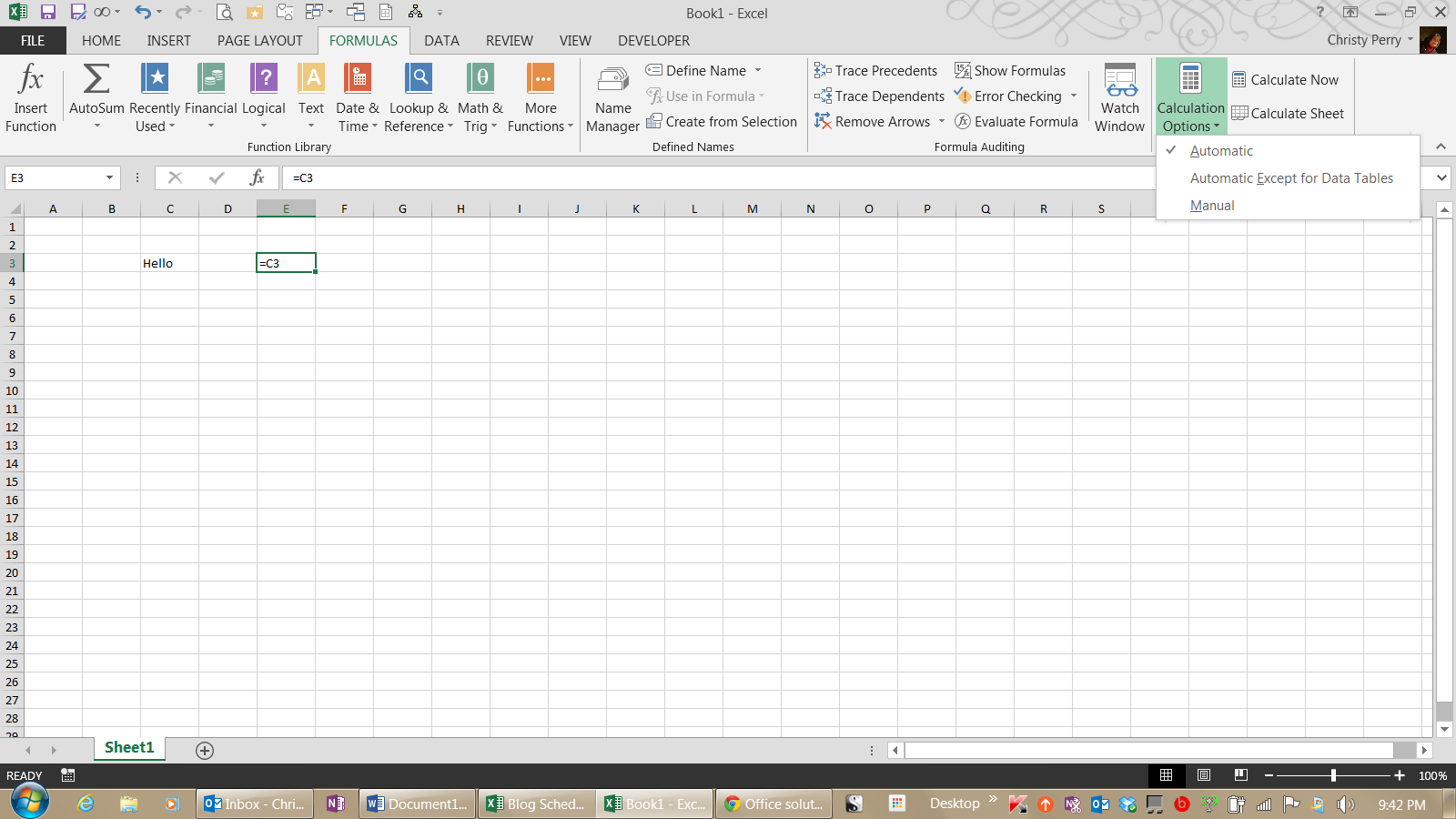
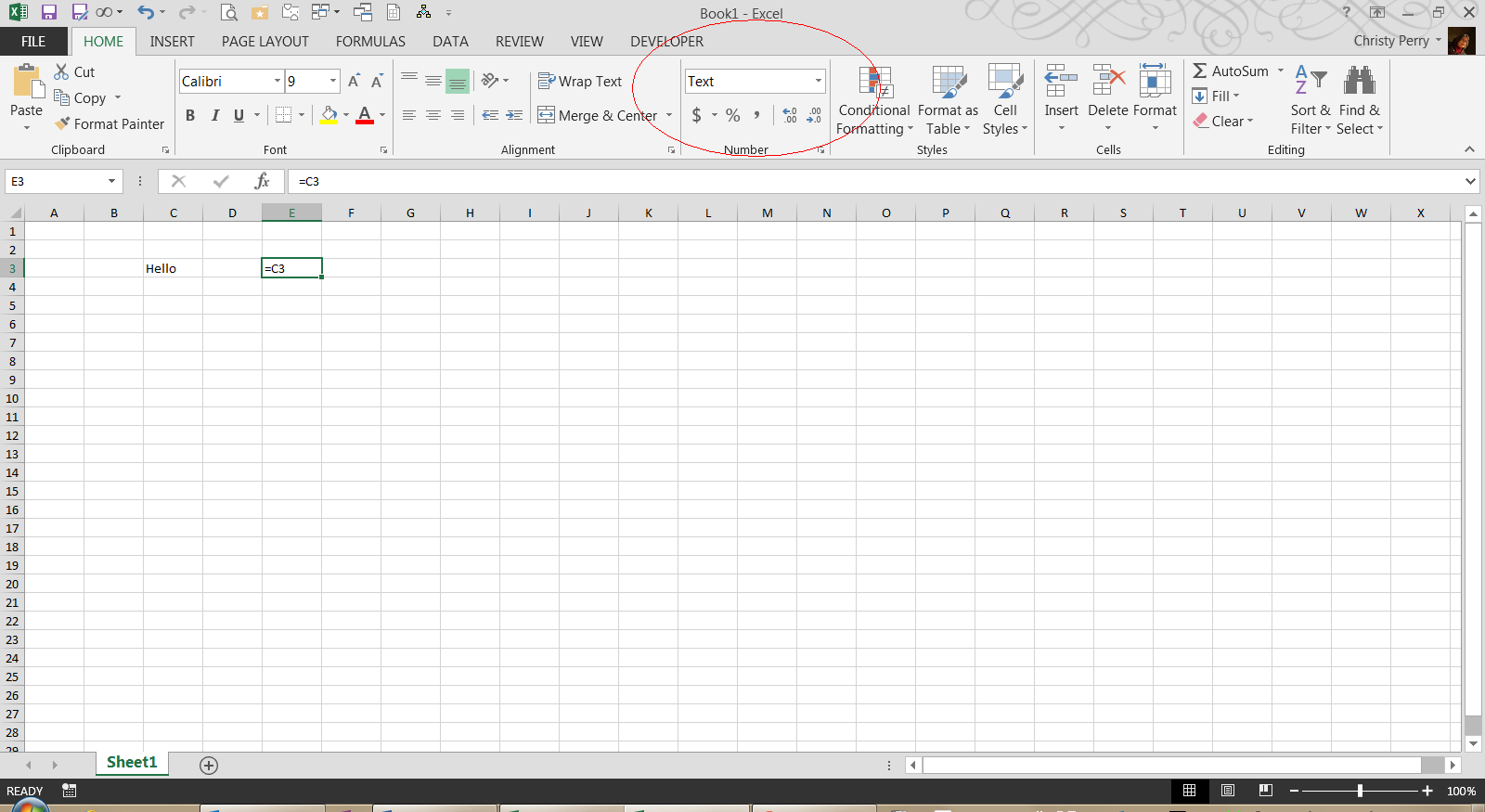

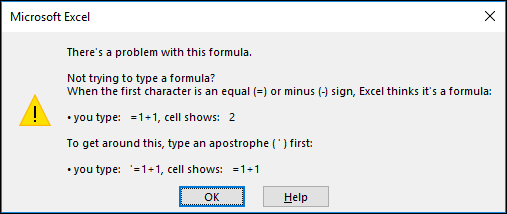

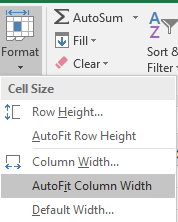

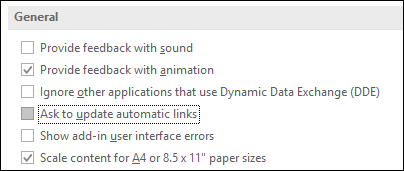
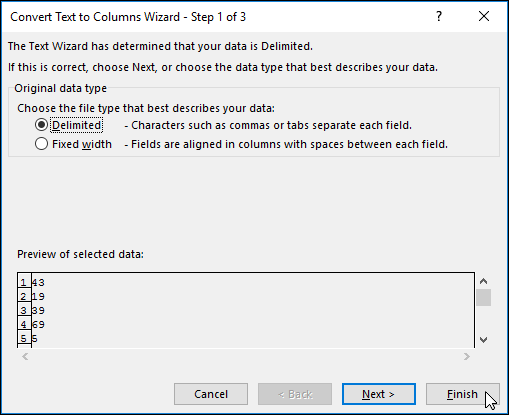
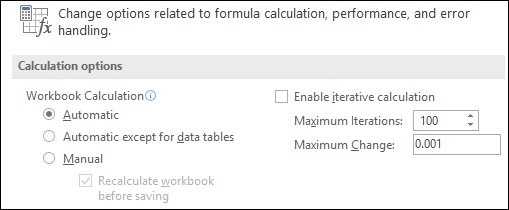
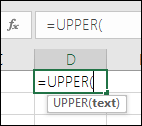
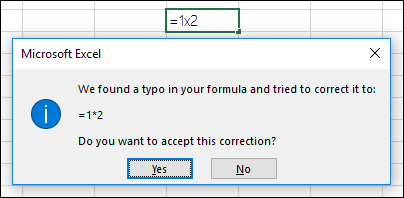
 .
.
 , and then select Paste Values, or press Alt > E > S > V > Enter for Windows, or Option > Command > V > V > Enter on a Mac.
, and then select Paste Values, or press Alt > E > S > V > Enter for Windows, or Option > Command > V > V > Enter on a Mac.
